|
"Bone technology is a
subject every bit as complex as stone technology--."--------1982,
Frison, George C. and Carolyn Craig, "Bone, Antler And Ivory
Artifacts And Manufacture Technology," The Agate Basin Site, p. 157.
"Bone arrow points are
rare and are only found in small numbers on a few sites."---1985,
Gregory Perino, "Selected Preforms, Points and Knives of the North
American Indians," p. 40.
"The use of bone and
related (organic) materials----was almost universal among Indian
tribes,"---1912, Frederick Webb Hodge,
"Bone-Work," Handbook of American Indians North of Mexico, p. 159
"Among the
Indian tribes many (arrow points)
were made of flint and other varieties of stone, as well as bone, horn,
antler, shell, wood, and copper."------1912,
Frederick Webb Hodge, "Arrowheads,"
Handbook Of American Indians North Of Mexico,
Part I,
p. 90.
"Before the
natives came into contact with the whites, they made harpoons of wood,
bone, walrus ivory, shell, stone, sinew, and hide."------1912,
Frederick Webb Hodge, "Harpoons,"
Handbook Of American Indians North Of Mexico,
Part I, p. 533.
"Bone points
are common from the Aurignacian (34,000
to 29,000 years ago) onward and the
Magdalenian (17,000 to 11,500 years
ago) harpoons were almost certainly
part of a composite spear."--------1988,
Ian Tattersall, "Spear," Encyclopedia Of Human Evolution And
Prehistory, pp. 335-336.
"Since
the first spears were probably made from wood or horn, it is unlikely
that very early forms of such artifacts would be preserved in the
prehistoric record except under unusual conditions."----1988,
Ian Tattersall, "Spear," Encyclopedia Of Human Evolution And
Prehistory, pp. 335-336.
"In the
Hassler collection of the Field Columbian Museum are barbed harpoons
from southern Brazil. The bone of an animal forms the point and a barbed
piece of hard wood the tang of the head, which is attached by a short
piece of rope to the end of the long shaft"---------1902,
Otis Tufton Mason, "Aboriginal American Harpoons: A Study In Ethnic
Distribution And Invention," Annual Report Of The U.S. National
Museum, p. 150.

ORGANIC PROJECTILE POINTS
WORLDWIDE
RECENT TO 450,000 YEARS AGO
Stone is the most common and durable material
that is found on archaeological sites and the most studied medium of
the ancient craftsmen. But the most interesting sites are the ones that
preserve the organic materials. The most exciting of these sites are the
oldest. Extremely old artifacts that were made of organic materials
have survived but they almost disappear from the archaeological record
beyond 500,000 years ago. Preservation of these carbon based materials
depends on many factors, such as, the chemistry of the soil, amount of
oxygen, temperature, erosion from wind and rain, sun exposure, natural
geological events, and even animal gnawing, just to name a few. The
earliest sites with the best organic preservation will always provide
the most information. |
|
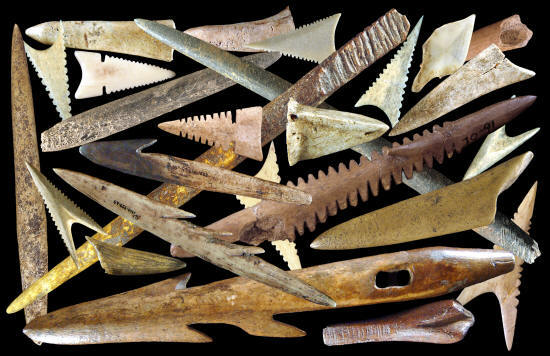
CLICK ON PICTURE FOR LARGER IMAGE
PROJECTILE POINTS
MADE FROM ORGANIC MATERIALS
PALEO, WOODLAND AND MISSISSIPPIAN
PERIODS
All of the artifacts in this picture
are made from organic materials. The materials are antler, bone,
ivory and gar scale. They were once attached to arrows, spears and
harpoons. These types of artifacts are unique for the fact that they
have survived the destructive forces of nature. Archaeological sites
that have organic artifacts offer the most information, especially
the older sites. |
|
|
Projectile points were made and used wherever humans have lived. They were made from every kind
of organic and non-organic material that was sturdy enough to hold a
point. The most popular organic materials were,
antler, bone, ivory and wood. Some of the more "exotic" materials would include such
things as piranha teeth on the ends of blowgun darts or darts made from
palm leaf midribs or thorns, arrow points made from bamboo, gar scale
arrow points and arrow points made from shell. |
|
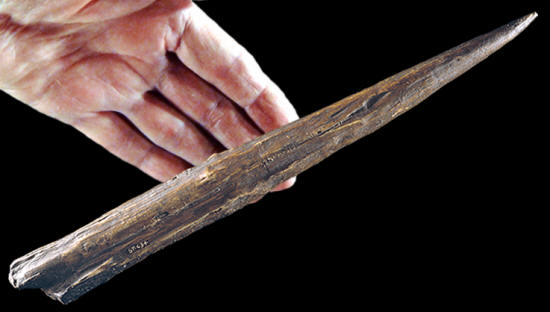
CAST FROM THE COLLECTION OF CRAFT RESEARCH CENTER, INDIANA
UNIVERSITY
CLICK ON PICTURE FOR LARGER IMAGE
THE CLACTON SPEAR TIP
CLACTON-ON-SEA, ESSEX, UNITED
KINGDOM
LOWER PALEOLITHIC PERIOD
est.300,000 to 450,000 YEARS AGO
The "Clacton spear tip" is the oldest
wooden artifact ever found in Britain. Estimates of its age range
from 300,000 to 450,000 years old. The original spear tip has warped
and shrunk since its discovery. This picture shows an early cast of
the artifact. The name comes from Clacton-On-Sea, England where it
was found. The Clacton spear was discovered in interglacial deposits
in 1911 by J. Hazzledine Warren. Experiments show that one of the
most efficient ways the sharpened tip could be made was by using
fire, grinding and scraping processes. Charring the tip of the shaft
in fire then grinding off the burnt material on the ground and on a
stone complete the initial manufacturing stage. Then the point was
finished with a unifacial scraping tool. The total time using fire
was 45 minutes compared with other manufacturing experiments that
took one and a half to two hours to complete. The Clacton spear is
made of yew wood and its earliest measurements, before it shrunk,
are 15 1/4 inches (38.7 cm) long and 1 1/2 inches (3.8 cm) at its
widest. |
|
|
In most cases, people used the best and most readily
available materials for projectile points. In areas of dense jungle the
best source is plant materials from wood, bamboo and other
types of plant fibers. In the arctic regions some of the most common
materials used for projectile points were bone and ivory. In many areas of the world, where
local resources were not so restricted and the
climate was not so extreme, people could chose from a much wider range
of materials. |
|
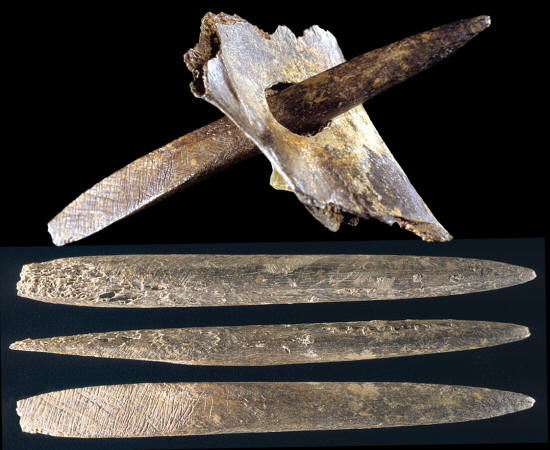
CLICK ON PICTURE FOR LARGER IMAGE
PERFORATED
SCAPULA & BONE POINT
SHERIDEN CAVE SITE, WYANDOT COUNTY, OHIO
CLOVIS CULTURE
Ice
Age people were using bone projectile points to hunt extinct species of peccaries. The best
evidence for this was found in Sheridan Cave in Wyandot County, Ohio.
This picture shows a fragment of a peccary scapula with an almost
perfectly round hole. The bone spear point laying through the hole was found nearby and may be the projectile that
brought down this animal more than 11,000 years ago. It was found in the
summer of 1995 by Kenneth Ford while excavating the skeleton of a
flat-faced peccary. The tip of the point does have
some impact damage. These two artifacts are positioned to show the
direction from which the spear point perforated the bone. One side has a
small entrance hole and the other side has a larger exit hole. This
point was made from the long bone of a large animal and it measures 5
1/4 inches (13.4 cm) long. |
|
|
The oldest "organic" projectile points are sharpened wooden
spears that are thought to have been used as javelins. One of the more
recent finds are three wooden spears that were found in 1995 in a coal
mine near Hannover, Germany and are believed to date to 400,000 years
ago. They are made of spruce and measure between six and seven feet
long. A shorter fourth spear with points on both ends was also found but
it's thought that it may have been either a thrusting spear or throwing
stick. |
|
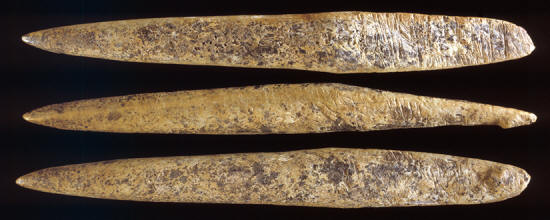
CLICK ON PICTURE FOR LARGER IMAGE
BONE POINT
SHERIDEN CAVE SITE, WYANDOT COUNTY, OHIO
CLOVIS CULTURE
This bone point was found inside Sheriden
Cave in 2000. The tip of the point is in very good condition and is
slightly polished. The base of this point has a design feature in the
form of a small knob that probably helped to secure the point to the end
of a spear. This point was made from the long bone of a large animal and
it measures 4 11/16 inches (11.9 cm) long. |
|
|
The "Clacton spear tip" is a broken end of another very early
javelin-like spear that is also thought to date to around 400,000 years
ago.
In fact, it's the oldest wooden
artifact ever found in Britain. Estimates of its age range from 300,000
to 450,000 years. It was discovered in interglacial deposits
in 1911 by J. Hazzledine Warren. The Clacton spear tip is made of
yew wood and it measures 15 1/4 inches (38.7 cm) long. |
|
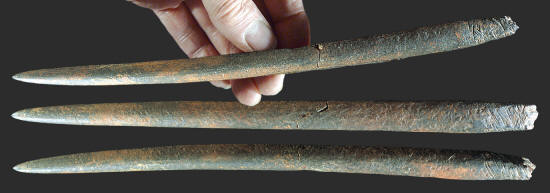
CLICK ON PICTURE FOR LARGER IMAGE
IVORY POINT OR FORESHAFT
AUCILLA RIVER
JEFFERSON COUNTY, FLORIDA
This slightly bowed ivory point was found in the Aucilla River in
northwest Florida and dates to sometime within the Paleo-Indian
period. It's a style that
has been used by widely separated cultures and time periods around the
world. These types of points were used by some Eskimo cultures and by
some early European people who were living during the Late Paleolithic
period. This ivory point was made from either a mammoth or mastodon
tusk. It was used on the
end of a spear as either a foreshaft or as a projectile point. If it was used
as a foreshaft, an additional projectile point would have been fitted
onto one end.
The
tapered end is engraved or "roughened" with several crosshatch lines.
The rough surface would help to secure any hafting materials, such as
mastic (glue) or sinew. Scuba divers have
retrieved large numbers of fragments of ivory points from Florida rivers
and limestone sinkholes. This is one of the few complete or nearly
complete examples that have been found. This ivory point measures 10
3/16 inches (25.9 cm) long. |
|
|
The oldest "organic" projectile points in North America date
to the Paleo-Indian period sometime before 11,000 years ago. The basic
shape is round with a point on one end and a flat taper on the other.
They are made of bone and ivory and range in size from 4 (10.2 cm) or 5
(12.7 cm) inches to over 10 inches (25.4 cm) long. The shorter examples
seem to have been spear points but the longer examples are
being interpreted as foreshafts that would attach to the end of a spear
and hold a projectile point. |
|
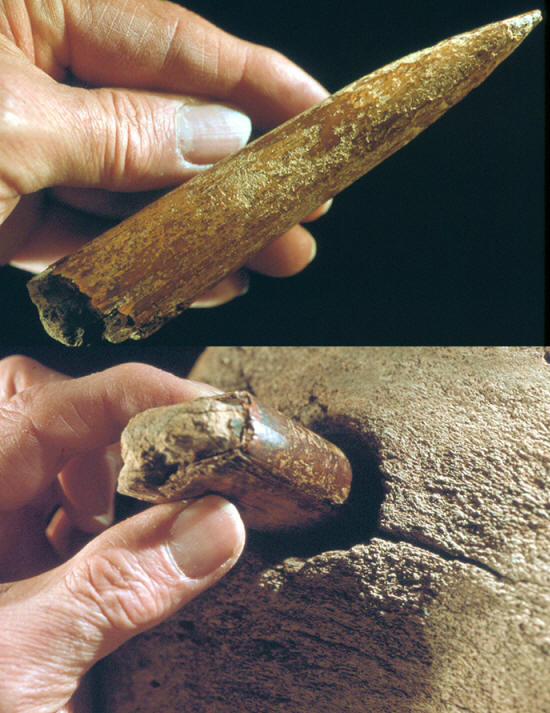
CLICK ON PICTURE FOR LARGER VIEW OF HARPOON TIP
BOWHEAD WHALEBONE WITH
IMBEDDED IVORY HARPOON
SAINT LAWRENCE ISLAND
IN THE BERING SEA
2120 YEARS BEFORE PRESENT
This broken tip of a walrus ivory harpoon and a bone segment of a bowhead whale's flipper
were collected several
years ago on the shore of Saint Lawrence Island in the Bering Sea.
The broken tip of the Walrus ivory harpoon or lance was found deeply imbedded in the bone.
This is a heavy duty projectile. Most whale harpoons have metal or stone
blades attached to the point. An x-ray of the bone shows that this
harpoon didn't have a cutting blade attached to the point. The piercing
end of this harpoon is flat and squared and has no sharp cutting edge.
The point was made by trimming away two opposite sides to form a chisel
tip. This ivory harpoon or
lance tip measures 4 3/4 inches (12 cm) long and 1 9/16 inches (4
cm) wide at the broken end. The whalebone measures slightly over 7
inches (18 cm) across in the x-ray. |
|
|
Ice
Age people were using bone projectile points to hunt extinct species of peccaries. The best evidence for this was found in 1995 in
Sheridan Cave in Wyandot County, Ohio. A fragment of a peccary scapula with an almost
perfectly round hole was found nearby a bone spear point that fits the
hole perfectly. One side of the scapula fragment has a small entrance
hole and the other side has a larger exit hole. The tip of the point
does seem to have some impact damage. The point was made from the long
bone of a large animal and it measures 5 1/4 inches (13.4 cm) long. |
|
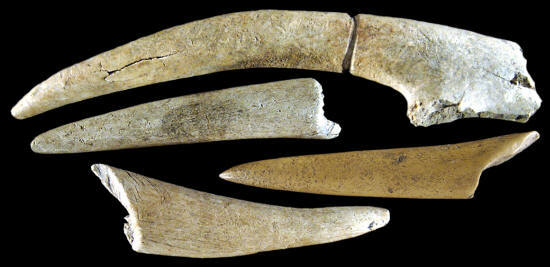
CLICK ON PICTURE FOR LARGER IMAGE
ANTLER "PREFABRICATE" &
BARBED POINTS
ILLINOIS & KENTUCKY
MIDDLE WOODLAND
est. 2,000 to 1,600 YEARS AGO
These four antler artifacts
were found on sites in Illinois and Kentucky. They date to the Middle
Woodland Hopewell culture. The lower three artifacts are barbed antler
projectile points. They are much larger than later Mississippian
period antler "arrow" points. Middle Woodland antler points were larger
because they were used on the ends of spears that were propelled through
the air with throwing sticks or atlatls. The segment of antler at top
shows how the antler was grooved prior to snapping, trimming and
drilling to finish a point. The antler point in the center is a cast.
All three antler points were found on the Snyders
site. The longest point measures 3 7/8 inches (9.9 cm) long. |
|
|
The excavation of Sheriden Cave produced to bone points. The
other bone point was found inside the
Cave in 2000. The tip of this point is in very good condition and is
slightly polished. The base of the point has a design feature in the
form of a small knob that probably helped to secure the point to the end
of a spear. This point was made from the long bone of a large animal and
it measures 4 11/16 inches (11.9 cm) long. |
|
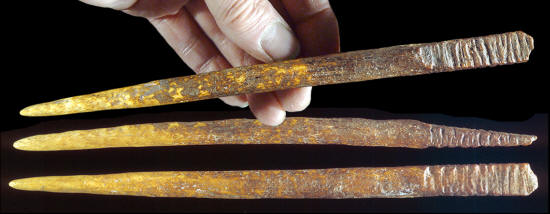
CLICK ON PICTURE FOR LARGER IMAGE
IVORY POINT
ESKIMO CULTURE
NORTH AMERICA
This ivory point
was made by one of the Eskimo cultures. It may have been used on the end
of a spear as either a foreshaft or as a projectile point. If it was a
foreshaft, an additional harpoon style point would have been fitted onto
the pointed end. The roughened tapered end was attached (hafted) to the
end of a spear shaft. This point measures 8 3/4 inches (22.2 cm) long. |
|
|
The
largest number of ivory points found in the U.S.
come from the Aucilla River in northwest Florida. They date to sometime
within the Paleo-Indian period. The style is basically the same as the
bone points from Sheriden Cave, only longer. In fact, it's a style that
has been used by widely separated cultures and time periods around the
world. These types of points were used by some Eskimo cultures and by
some early European people who were living during the Late Paleolithic
period. They may have been used
on the ends of spears as foreshafts or as projectile points. If they
were used as foreshafts, an additional projectile point would have been
fitted onto one end.
The
tapered end is engraved or "roughened" with several crosshatch
lines. The rough surface would help to secure any hafting materials,
such as mastic (glue) or sinew, to the end of a spear. |
|
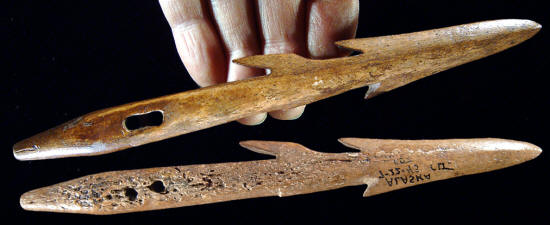
CLICK ON PICTURE FOR LARGER IMAGE
BARBED HARPOON
ESKIMO CULTURE
NORTH AMERICA
This Eskimo barbed harpoon is made from bone. It originally had four
barbs but one apparently broke and the surface was cut and polished
to a smooth finish. People of the Artic regions, from Siberia to
Greenland, made and used an almost endless variety of different
styles and sizes of harpoon projectile points. They were
specifically designed to hunt the different kinds of Artic animals
from seals to the massive whales. This barbed harpoon measures 7 1/4
inches (18.4 cm) long. |
|
|
The largest numbers of bone and ivory projectile points come
from Eskimo sites in the form of harpoons. They are found on ancient and
recent sites across the north countries of Siberia into Alaska, Canada
and Greenland. The cold climate and frozen ground has preserved much of
the organic materials, even on the most ancient sites. There are two
different types of true harpoons. One is called a barbed harpoon and the
other is a toggle harpoon. Both types detach from the shaft and
foreshaft when they are driven into an animal. The hunter or float is
then connected to the animal by a line. |
|
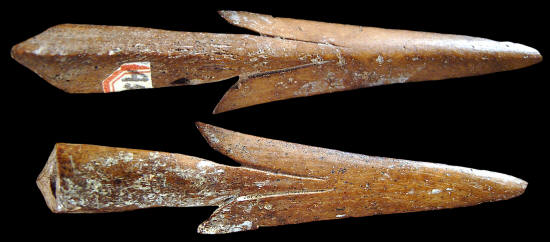
CLICK ON PICTURE FOR LARGER IMAGE
BARBED TOGGLE HEAD HARPOON
ESKIMO CULTURE
NORTH AMERICA
This point represents a
common type of barbed toggle head harpoon. One of this size would have
been used to hunt animals such as seals. This harpoon is made of bone
and measures 3 5/8 inches (9.2 cm) long. |
|
|
One
example of cold climate preservation involves the discovery of a broken
piece of an ivory harpoon or lance tip that was embedded in a bone segment of a bowhead
whale's flipper. It was found on
the shore of Saint Lawrence Island in the Bearing Sea. Both the whalebone and
the ivory harpoon produced radiocarbon dates of 2120+/-40BP and
2050+/-40BP years before present. This is the earliest physical evidence
for hunting whale, other than engravings of whaling scenes. |
|

BLUNT ARROW POINT
ESKIMO CULTURE
NORTH AMERICA
This blunt was made by one
of the Eskimo cultures. The main purpose of a blunted arrow is to
preserve the arrow and stun the animal. They are used on small game,
such as birds and rabbits. Sharp pointed arrows serve no purpose with
this type of hunting and will result in more arrow point repair.
On-the-other-hand, blunts are
very sturdy and difficult to break. The majority of pre-metal societies
made their blunts out of wood, bone and ivory. This blunt is made of
bone and it measures 2 1/4 inches (5.7 cm) long. |
|
|
A unique type of arrow
point is the blunt. They are unique because they were made without a
pointed end for piercing and almost always were made from organic
materials. The main purpose of
a blunted arrow is to preserve the arrow and stun the animal. They are
used on small game, such as birds and rabbits. Sharp pointed arrows
serve no purpose with this type of hunting and will result in more arrow
point repair. On-the-other-hand, blunts are
very sturdy and difficult to break. The majority of pre-metal societies
made their blunts out of wood, bone and ivory. |
|
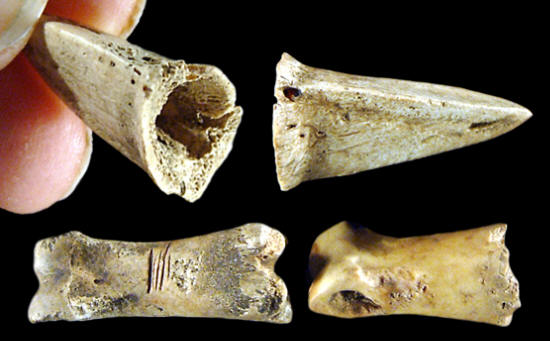
CLICK ON PICTURE FOR LARGER IMAGE
DEER PHALANX ARROW POINT &
DEER PHALANGES
KENTUCKY
MISSISSIPPIAN CULTURE
This picture shows one of the more rare varieties of bone arrow
points. They have been reported from states on both sides of the
Mississippi River. These points were made from the lower foot bones
of deer, called phalanx bones. Phalanges is the word used for
plural, and they are also referred to as deer toe bones. The bones
were cut, ground into shape and hollowed out for a socket for
hafting onto an arrow shaft. The example in this picture is three
sided with straight sharp edges and a flared base. It measures 1
3/16 inches (3.1 cm) long and 5/8 inch (1.6 cm) wide. |
|
|
The most common types of "organic" projectile points found on
prehistoric sites in the U.S. were made from antler.
Antler projectile
points were used for thousands of years in North America, beginning
sometime during the Late Archaic period. The earliest antler points were
used as spear or dart points and were much larger than the later period arrow points. There were two main styles. Some were made with a
projecting barb and others were made with
squared off bases, without barbs. The more recent, Mississippian period,
antler arrow points date from about 1,400 years ago to historic times,
when they were replaced by conical metal points. |
|
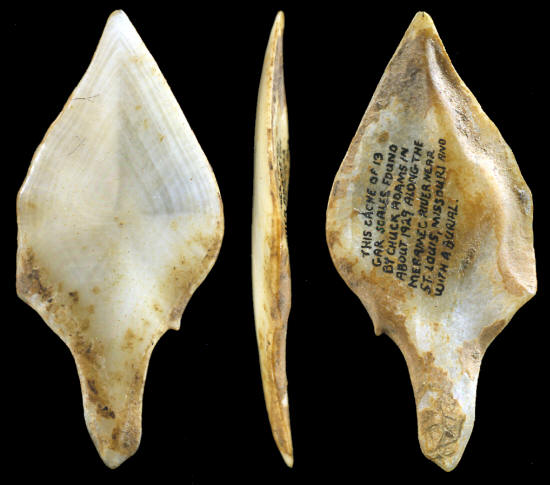
CLICK ON PICTURE FOR LARGE IMAGE OF 13 POINTS
GAR
SCALE ARROW POINT
MISSISSIPPIAN CULTURE
ST. LOUIS COUNTY, MISSOURI
This is the largest gar scale in the cache of thirteen that were found
by Chuck Adams in 1929. They have all turned yellow with age and are heavily patinated.
Gar scales have a natural shape in the form of a point, sharp edges and
a stem that is ready made for use as arrow points. It's possible that
gar scales were in
use as early as A.D. 200 with the beginning of bows and arrows in the
Mississippi Valley.
This gar scale measures 1 1/8 inches
(2.8 cm) long.
Gars are
freshwater fish that measure up to 10 feet (3m) in length and weigh up
to 300 pounds (135k). The scales that cover their bodies are made of a
very durable material with an enamel like coating on the
surface. These scales were also used for other things besides
arrowheads. In 1960 there were 40 fishhooks found with a burial near
Memphis, Tennessee that were made of gar scales. Ancient cultures around
the world have always utilized whatever they could from their local natural
resources and gar scales are just another example.
|
|
|
One of the more rare types
of bone arrow points found in the U.S. is reported from states on both sides of the
Mississippi River. These points were made from the lower foot bones
of deer, called phalanx bones. Phalanges is the word used for
plural. They are also referred to as deer toe bones. The bones
were cut and ground into a three-sided shape before hollowing out
the center into a socket for attachment to an arrow shaft. |
|
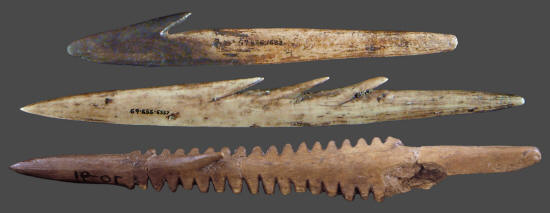
CLICK ON PICTURE FOR LARGER IMAGE
ANTLER & BONE HARPOONS
MISSISSIPPIAN CULTURE
CAHOKIA AND ZEBREE SITE
ARKANSAS & ILLINOIS
These three harpoons were
found during the excavation of the Zebree site in Arkansas (top
2) and Mound 72 on the Cahokia Mounds
site in Illinois (lowest 1).
The center example is made of antler and the other two are made from
bone. They all have barbs that were used as hooks to hold speared fish
or frogs. Single barbed examples from the Mississippian period are more
common than the three barbed example from the Zebree site. The two
harpoons from the Zebree site date to the Big Lake phase between 11200
and 950 years ago. The harpoon from Mound 72 at Cahokia is one of
several that were found. It represents one of the more complex forms
with serrations on much of its length and two long barbs. This is the
only nearly complete example that was salvaged from the site. The triple
barbed antler point in the center measures 4 1/4 inches (10.8 cm) long.
|
|
|
The rock hard scales from gars are another unique organic
material that was sometimes used for arrow points.
Gar scales have a natural shape in the form of a point, sharp edges and
a stem that is ready made for use as arrow points. It's possible that
gar scales were in
use as early as A.D. 200 with the beginning of bows and arrows in the
Mississippi Valley. Gars are
freshwater fish that measure up to 10 feet (3m) in length and weigh up
to 300 pounds (135k). The scales that cover their bodies are made of a
very durable material with an enamel like coating. |
|
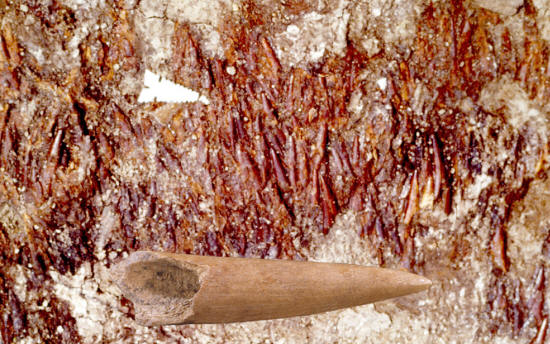
CLICK ON PICTURE FOR LARGER IMAGE
CACHE OF BARBED ANTLER ARROW
POINTS
MOUND 72
CAHOKIA MOUNDS SITE
ST. CLAIR COUNTY, ILLINOIS
This picture shows one of the largest caches of antler arrow points ever
found. They were discovered during the excavation of Mound 72, in about
1969, on the Cahokia Mounds site. The several hundred antler points in
this cache appear, by their alignment, to have been hafted onto arrows.
Antler points may have been a common point type used by Mississippian
people. They have been found on many
Mississippian sites in the southeastern U.S. The large antler point in
the picture shows a close-up view of one of the only examples that
survives from the excavation. |
|
|
Another type of "organic" projectile point are the single,
double and triple barbed harpoon or fish spearing points. They are made
of antler and bone materials. It's believed they were used to spear fish
or frogs. A single-barbed bone point and a triple-barbed antler point
was found during the excavation of the Zebree site in Arkansas and date to the Big
Lake phase between 11200 and 950 years ago. Several double-barbed
harpoons were discovered during the excavation of Mound 72 at Cahokia in
southern Illinois. They are complex forms that have serrations on much
of their length and two long barbs on opposite sides. |
|
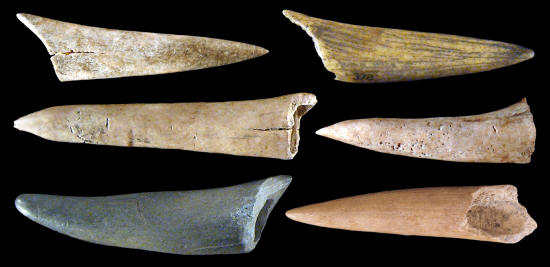
CLICK ON PICTURE FOR LARGER IMAGE
BARBED ANTLER ARROW POINTS
ETOWAH, CAHOKIA & A KENTUCKY SITE
GEORGIA, ILLINOIS AND KENTUCKY
These socketed barbed antler
arrow points were found on Mississippian period sites in Georgia,
Illinois and Kentucky. They were made from the tips of an antler tines.
The point at upper left was found on the Kunnemann tract on the Cahokia
Mounds site. The point at upper right (a
cast) was found
during the excavation of Mound C with burial #1 on the Etowah Mound
site. The point at lower right was found during the excavation of Mound
72 on the Cahokia Mounds site. The other three examples were discovered
on a site in Kentucky. The longest point measures 1 15/16 inches (5 cm)
long.
Antler projectile
points were used for thousands of years in North America, beginning
sometime during the Late Archaic period. The earliest antler points were
used as spear or dart points and were much larger than the arrow points
illustrated here. There were two main styles. Some were made with a
projecting barb, like most of these points and others were made with
squared off bases, without barbs. The more recent, Mississippian period,
antler arrow points date from about 1,400 years ago to historic times,
when they were replaced by conical metal points. |
|
|
Some of the most delicate and skillfully made bone
arrow points were made on the Cahokia Mounds site in Illinois. They are
interesting for the fact that many of them appear to be effigies of
sharks teeth. In fact, teeth from great white sharks have been
identified from this site. The Cahokia bone points were probably made from
deer bone. Although only two or three dozen are known, they were made in
several different styles. Most of them have serrated edges but
double-notched and un-notched triangular points have also been found
without serrations. The other styles include double-notched serrated
points with concave and straight bases and triangular serrated points
with concave bases. |
|
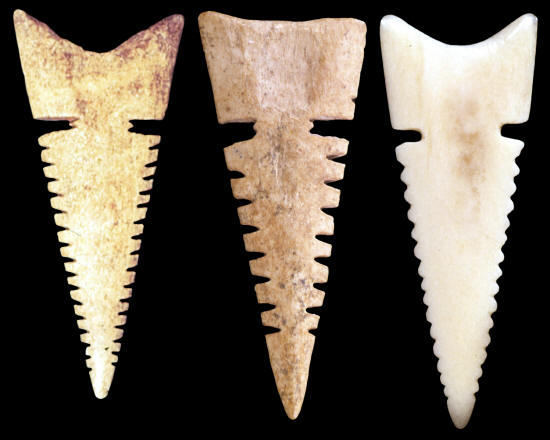
CLICK ON PICTURE FOR LARGER IMAGE
DOUBLE-NOTCHED SERRATED
BONE CAHOKIA POINTS
CAHOKIA MOUNDS SITE
MADISON/ST. CLAIR COUNTIES, ILLINOIS
These three bone Cahokia points are some of the best examples that
have been found on the Cahokia Mounds site. Their double-notched
serrated style is the same as some stone points that have been found
on the site. Most of the bone arrow points from Cahokia have edge
serrations and most of the stone points are un-serrated.
The point on the right is highly
polished and measures 1 3/8 inches (3.5 cm) long. |
|
|
Shell
arrow points have also been reported but they are very rare. One of the
best examples is described in a report
written in 1988 by Terry Jones. The report describes a small abalone shell Desert
Side-Notched point that was found during the excavation of a shell
midden. The project was a salvage/rescue excavation on a 1,000 year old
site located south of Monterey, California. The point measures 1 1/16
inches (2.6 cm) long. The
report describes the manufacture technique as the same as for the
manufacture of shell ornaments. The point was made by cutting and
grinding and not by flaking. The author describes the discovery; "As far
as is known, no shell projectile point has ever been reported from
California before." |
|
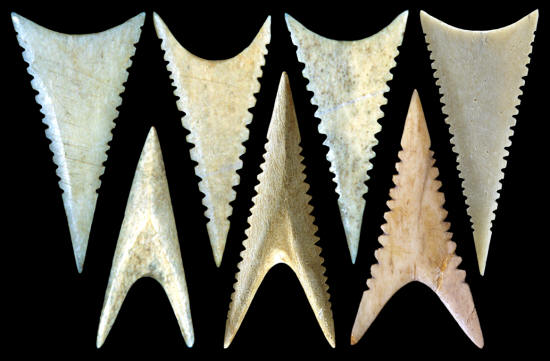
CLICK ON PICTURE FOR LARGER IMAGE
TRIANGULAR SERRATED
BONE CAHOKIA POINTS
CAHOKIA MOUNDS SITE
MADISON/ST. CLAIR COUNTIES, ILLINOIS
The seven bone
Cahokia points in this picture are some of the best examples for this
type. They were surface collected, many years ago, on the Cahokia Mounds
site. Three of them are in the Gilcrease Museum in Tulsa, Oklahoma and
the rest are in private collections.
Although rare, these points are the more
common "un-notched" style of bone points. They
have concave bases with very straight serrated edges and are fairly
thin. The point at lower left is the exception without a serrated edge.
Sharks teeth have been found on the Cahokia Mounds site and it's
believed that these styles of points might be effigies of sharks teeth.
All of these points may be made of deer bone. The point at top right
measures 1 7/16 inches (3.6 cm) long, 5/8 inch (1.5 cm) wide and 1/16
inch (1.1 mm) thick. |
|
|
There has been a long history of plant fiber use for
projectile points in areas of dense jungle in the regions of South
America, Southeast Asia, Borneo, Indonesia and New Guinea. Wood, bamboo and other
plant materials were commonly used for the production of arrow
points and blowgun darts. People living in New Guinea still make and use
several different types of arrow points from wood, bone and bamboo and
still use them as weapons. A recent attack in Papua New Guinea on June
19, 2011 by a local tribesman shot a New Zealand man twice with arrows.
The report says; "The arrow went into his right lung and the other
through his ribs, under his liver and through his stomach, stopping
short of the aorta." The man did survive. |
|
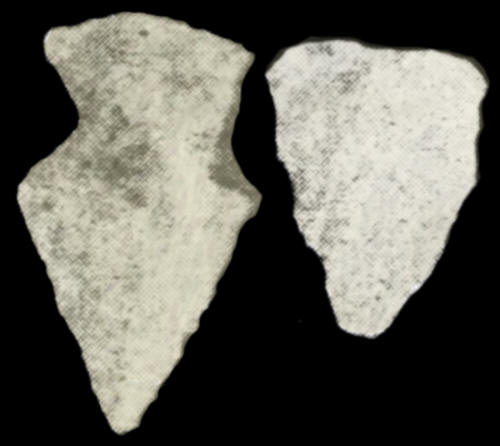
SHELL ARROW POINTS
SOUTHWESTERN U.S.
Shell
arrow points have been reported but they are very rare. This picture shows
two examples from a group of southwestern shell artifacts that were
published over 120 years ago in "Popular Science Monthly." A report
written in 1988 by Terry Jones describes a small abalone shell Desert
Side-Notched point that was found during the excavation of a shell
midden. The project was a salvage/rescue excavation on a 1,000 year old
site located south of Monterey, California. The point measures 1 1/16
inches (2.6 cm) long, 1/2 inch (1.35 cm) wide and (2 mm) thick. The
report describes the manufacture technique as the same as for the
manufacture of shell ornaments. The point was made by cutting and
grinding and not by flaking. The author describes the discovery; "As far
as is known, no shell projectile point has ever been reported from
California before." |
|
|
No one knows when the first blowguns began to be used. But
they have been used on all inhabited continents at one time or another.
They have been used by many different cultures, from Japanese Ninja
assassins to Brazilian jungle tribal hunters. In the U.S., blowguns have
been used by the Choctaw, Cherokee, Creek and Houma tribes in the
southeast. Although some blowguns shot clay or stone pellets, most were
using some type of plant fiber dart made from the midribs of palm
leaves, bamboo or wood. Some are even reported to be tipped with piranha
teeth. The earliest descriptions of blowguns are from Rome 1,800 years
ago. It is interesting to note that although blowgun darts are lighter
and expend less energy than arrows they can travel twice as fast. |
|
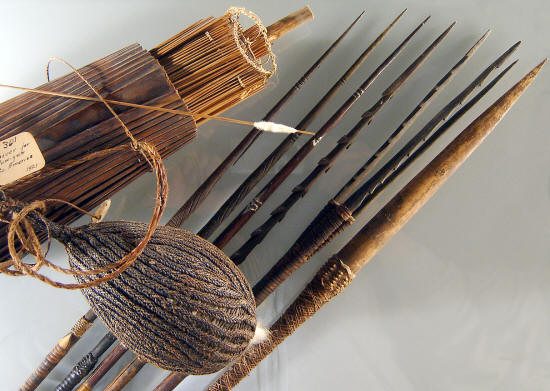
CLICK ON PICTURE FOR LARGER IMAGE
WOOD AND PLANT FIBER
ARROW POINTS & BLOWGUN
DARTS
NEW GUINEA & SOUTH AMERICA
Wood, bamboo and other plant fibers
were commonly used for the production of arrow points and blowgun
darts. Before the age of metal, these materials were used almost
exclusively for projectile points in areas of dense forests and tropical
jungle. This picture shows six different examples of arrow points, from
New Guinea, that are made of wood and bamboo. The four long round and
barbed points on the left measure about 12 inches (30.5 cm) long. The
cane shafts measure between 36 and 48 inches (91.4 cm to 122 cm) long.
The bamboo point on the right is wide and curved and is designed for
causing wounds that bleed and used to shoot pigs. The arrow second from
the right is a leister design with three prongs that are barbed. This
arrow would be used to shoot fish or birds. The other four points have
very sharp points and are long and narrow with shallow barbs and long
splinter-like barbs. These would be used in warfare to shoot people.
This picture also shows a hundred year old quiver that
contains hundreds of blowgun darts that were made by people living in
the region around eastern Peru and western Brazil. The tip of each dart
is stained with some type of poison, possibly curare. The woven bag
holds the cotton-like fiber that is twisted onto the end of each dart
before it's propelled through the air with a blowgun. Blowguns have been
used on all inhabited continents at one time or another by Japanese
Ninja assassins to Brazilian jungle tribal hunters. In the U.S.,
blowguns have been used by the Choctaw, Cherokee, Creek and Houma tribes
in the southeast. Although some blowguns shot clay or stone pellets,
most were using some type of plant fiber dart made from the midribs of
palm leaves, bamboo or wood. The earliest descriptions of blowguns are
from Rome 1,800 years ago. |
|
|
The worldwide development of so many different types of
projectile points and devices to propel them is extraordinary. The
ability of people to use and take advantage of their natural resources
is a testament to their ingenuity and tenacity to survive in all types
of environments, from the coldest Arctic to the hottest jungles and
deserts. |
|
"REFERENCES"
1902, Mason, Otis Tufton, "Aboriginal American Harpoons: A Study In Ethnic
Distribution And Invention," Annual Report Of The U.S. National
Museum, p. 197-304..
1912, Hodge, Frederick Webb, "Bone-Work," Handbook of American
Indians North of Mexico, p. 159.
1912, Hodge, Frederick Webb, "Arrowheads,"
Handbook Of American Indians North Of Mexico,
Part I,
p. 90.
1912, Hodge, Frederick Webb, "Harpoons,"
Handbook Of American Indians North Of Mexico,
Part I, p. 533.
1982, Frison, George C. and Carolyn Craig, "Bone, Antler And Ivory
Artifacts And Manufacture Technology," The Agate Basin Site, p. 157.
1983, Morse, Dan F. & Morse, Phyllis A., "Archaeology Of The Central
Mississippi Valley," p. 223-224.
1985, Perino, Gregory, "Selected Preforms, Points and Knives of the
North American Indians," p. 40.
1988, Tattersall, Ian, "Spear," Encyclopedia Of Human Evolution And
Prehistory, pp. 335-336.
1988, Jones, Terry, "A Shell Projectile Point From The Big Sur
Coast, California," Journal Of California And Great Basin
Anthropology, Vol. 10, Issue 1.
1999, Bridcland, David R., "Middle Pleistocene Interglacial
Thames-Medway Deposits At Clacton-On-Sea, England:" Quaternary
Science Reviews, 18, p. 110.
|
|
RECENT
LISTINGS HOME
ORDERING |